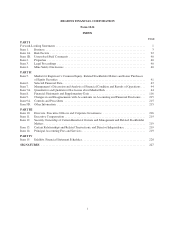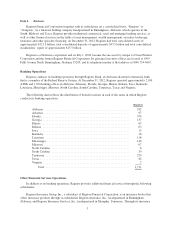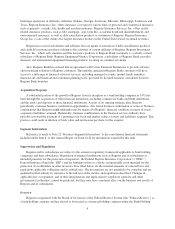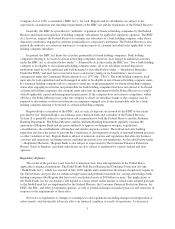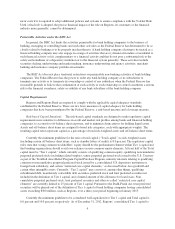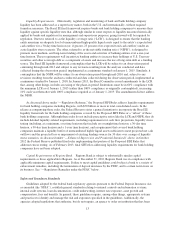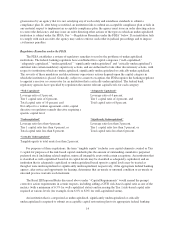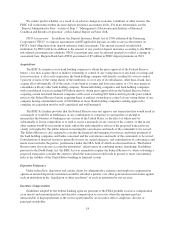Regions Bank 2012 Annual Report Download - page 25
Download and view the complete annual report
Please find page 25 of the 2012 Regions Bank annual report below. You can navigate through the pages in the report by either clicking on the pages listed below, or by using the keyword search tool below to find specific information within the annual report.incur costs if it is required to adopt additional policies and systems to ensure compliance with the Volcker Rule.
Until a final rule is adopted, the precise financial impact of the rule on Regions, its customers or the financial
industry more generally, cannot be determined.
Permissible Activities under the BHC Act
In general, the BHC Act limits the activities permissible for bank holding companies to the business of
banking, managing or controlling banks and such other activities as the Federal Reserve has determined to be so
closely related to banking as to be properly incident thereto. A bank holding company electing to be treated as a
financial holding company may also engage in a range of activities that are (i) financial in nature or incidental to
such financial activity or (ii) complementary to a financial activity and that do not pose a substantial risk to the
safety and soundness of a depository institution or to the financial system generally. These activities include
securities dealing, underwriting and market making, insurance underwriting and agency activities, merchant
banking and insurance company portfolio investments.
The BHC Act does not place territorial restrictions on permissible non-banking activities of bank holding
companies. The Federal Reserve has the power to order any bank holding company or its subsidiaries to
terminate any activity or to terminate its ownership or control of any subsidiary when the Federal Reserve has
reasonable grounds to believe that continuation of such activity or such ownership or control constitutes a serious
risk to the financial soundness, safety or stability of any bank subsidiary of the bank holding company.
Capital Requirements
Regions and Regions Bank are required to comply with the applicable capital adequacy standards
established by the Federal Reserve. There are two basic measures of capital adequacy for bank holding
companies that have been promulgated by the Federal Reserve: a risk-based measure and a leverage measure.
Risk-based Capital Standards. The risk-based capital standards are designed to make regulatory capital
requirements more sensitive to differences in credit and market risk profiles among banks and financial holding
companies, to account for off-balance sheet exposure, and to minimize disincentives for holding liquid assets.
Assets and off-balance sheet items are assigned to broad risk categories, each with appropriate weights. The
resulting capital ratios represent capital as a percentage of total risk-weighted assets and off-balance sheet items.
Currently the minimum guideline for the ratio of total capital (“Total capital”) to risk-weighted assets
(including certain off-balance sheet items, such as standby letters of credit) is 8.0 percent. The regulatory capital
rules state that voting common stockholders’ equity should be the predominant element within Tier 1 capital and
that banking organizations should avoid over-reliance on non-common equity elements. At least half of the Total
capital must be “Tier 1 capital,” which currently consists of qualifying common equity, qualifying noncumulative
perpetual preferred stock (including related surplus), senior perpetual preferred stock issued to the U.S. Treasury
as part of the Troubled Asset Relief Program Capital Purchase Program, minority interests relating to qualifying
common or noncumulative perpetual preferred stock issued by a consolidated U.S. depository institution or
foreign bank subsidiary, and certain “restricted core capital elements,” as discussed below, less goodwill and
certain other intangible assets. Currently, “Tier 2 capital” may consist of, among other things, qualifying
subordinated debt, mandatorily convertible debt securities, preferred stock and trust preferred securities not
included in the definition of Tier 1 capital, and a limited amount of the allowance for loan losses. Non-
cumulative perpetual preferred stock, trust preferred securities and other so-called “restricted core capital
elements” are currently limited to 25 percent of Tier 1 capital. Pursuant to the Dodd-Frank Act, trust preferred
securities will be phased-out of the definition of Tier 1 capital of bank holding companies having consolidated
assets exceeding $500 million, such as Regions, over a three-year period beginning in January 2013.
Currently the minimum guideline to be considered well-capitalized for Tier 1 capital and Total capital is
6.0 percent and 10.0 percent, respectively. As of December 31, 2012, Regions’ consolidated Tier 1 capital to
9



